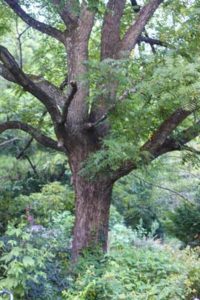Time in Nature

Photo Credit for Emily Melvin
There are certain benefits to spending time in nature filled with natural vegetation and a few scientific findings that provide further support for doing so.
You may remember a Good Fat Company blog entry from last summer; Healthy Benefits of Time with Mother Nature. The keyword that could trigger an action step is time. It is so critical to developing a balanced schedule inclusive of healthful living priorities. I hope the miscellaneous snippets of material below helps encourage this practice.
Opportunity for Physical Activity
Outdoor natural spaces provide a diverse opportunity for recreational activities that can be both fun and efficacious for physical fitness. Furthermore, some research has demonstrated support for the theory that physical activity in green space is more effective in enhancing psycho-social well-being as compared to physical activity performed in other environments (Sharma-Brymer, Brymer, & Davids, 2015). This research stems from “ecological dynamics”, an approach that assesses the nervous system in athletics with respective relationships between the human body and the environment in which it performs (Teques, et al., 2017).
Mood and Well-being
Support for enhancements to mood and well-being as a result of spending time in nature covers a range of subsidiary topics. One study suggested that as little as a short walk through nature could result in a reduction of rumination, which includes the tendency to dwell on negative experiences and can be a factor in the development of mental illness (Bratman, et al., 2015). Furthermore, a systematic review on the health benefits of green spaces found that quantity of green space around a person’s living environment has a significant positive effect on perceived mental health (van den Berg, 2015).
Benefit for Children
Studies have demonstrated that children may benefit in terms of healthful development, well-being, and favorable attitude as a result of spending time in nature (Gill, 2014). Furthermore, some researchers, in favor of increasing trees and natural areas around children, suggest creative play is encouraged as a result of exposure to nature (Chawla, 2015).
Improved Quality of Life in Urban Areas
In addition to well-being and recreational benefit, vegetation in urban areas may contribute to improved air quality and can serve as a cooling agent for heat generated in dense, urbanized environments (Kabisch, van den Bosch, & Lafortezza, 2017). Furthermore, even just the addition of a greater green cover, ie “urban canopy”, could present some health benefit for conditions such as asthma or cardiovascular-related disease (Kardan, et al., 2015 and Ulmer, et al., 2016). This is particularly relevant to consider in context of a global trend towards urbanization.
Microbial Biodiversity
There is a lot of buzz about microbiota and the microbiome these days (click here for further detail). This leads us towards a slightly overused phrase “gut health” (…and a much bigger area of discussion for the scope of this blog post). However, to put it simply, science is emerging. We have come to understand that our gut flora, the community of microorganisms living in our digestive tract, respond to variety. Exposures to diversity in our biological environment, as long as natural and favorable vs adverse, antagonistic environmental exposures, can serve as a catalyst to encourage more favorable balance for the microbiota in our “gut” and the health of our respective immune system. The WHO (World Health Organization) published a rather lengthy document detailing the state of knowledge on associations between biodiversity and human health in 2015.
Healthful “green” living is more than just eating your greens. Soak up natural, biological elements through environmental exposures as well, reap the many rewards, and bring snacks from Good Fat Company along for your journey!
Enjoy your summer!
Ashley Arnold
—
Ashley runs a lifestyle health coaching service centered on evidence-based behavioral change and systematized approaches from integrative health services and healthcare. She includes functional health assessment tools that support setting more clear, realistic goals that are tailored to each client. She appreciates the products and mission of Good Fat Company due to the emphasis on whole-food, nutrition-rich products without processed additives or fillers. Also, that the product line is applicable across dietary spectrums from vegan to paleo and most anywhere in between. Further information can be found at www.ashleylarnold.com.
References:
Bratman, G. N., et al. (2015, Jul 14). Nature Experience Reduces Rumination and Subgenual Prefrontal Cortex Activation. Proceedings of National Academy of Science of the United States of America, 112(28), 8567-8572.
Chawla, L. (2015, Jul 22). Benefits of Nature Contact for Children. Journal of Planning Literature, 30(4), 433-452.
Gill, T. (2014). The Benefits of Children’s Engagement with Nature: A Systematic Literature Review. Children, Youth, and Environments, 24(2), 10-34.
Goulet, O. (2015, Aug 1). Potential Role of the Intestinal Microbiota in Programming Health and Disease. Nutrition Reviews, 73(1), 32-40.
Kabisch, N., van den Bosch, M., & Lafortezza, R. (2017, Nov). The Health-Benefits of Nature Based Solutions to Urbanization Challenges for Children and the Elderly. Environmental Research, (159), 362-373.
Kardan, O., et al. (2015, Jul 9). Neighborhood Greenspace and Health in a Large Urban Center. Scientific Reports, 5(11610), 1-14.
Sharma-Brymer, V., Brymer, E., & Davids, K. (2015, Mar). The Relationship Between Physical Activity in Green Space and Human Health and Wellbeing: An Ecological Dynamics Perspective. Journal of Physical Education Research, 2(1), 7-22.
Teques, P., et al. (2017). Chapter 3 – The Resonant System: Linking Brain-Body-Environment in Sport Performance. Progress in Brain Research, 234, 33-52.
Ulmer J.M., et al. (2016, Nov). Multiple Health Benefits of Urban Tree Canopy: The Mounting Evidence for a Green Prescription. Health and Place, 42, 54-62.
van den Berg, M., et al. (2015). Health Benefits of Green Spaces in the Living Environment: A Systematic Review of Epidemiological Studies. Urban Forestry & Urban Greening, 14(4), 806-816.
World Health Organization and Secretariat of the Convention on Biological Diversity. (2015). Connecting Global Priorities: Biodiversity and Human Health, A State of Knowledge Review. Geneva, Switzerland: WHO Library Cataloguing-in-Publication Data.



